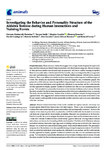Investigating the Behavior and Personality Structure of the Aldabra Tortoise during Human Interactions and Training Events
| dc.contributor.author | Quintavalle Pastorino, G | |
| dc.contributor.author | Smith, V | |
| dc.contributor.author | Faustini, M | |
| dc.contributor.author | Bonacina, E | |
| dc.contributor.author | Guadagnini, D | |
| dc.contributor.author | Robbiati, R | |
| dc.contributor.author | Cavalleri, A | |
| dc.contributor.author | Brereton, JE | |
| dc.contributor.author | Preziosi, Richard | |
| dc.date.accessioned | 2022-02-25T13:16:33Z | |
| dc.date.available | 2022-02-25T13:16:33Z | |
| dc.date.issued | 2022-02-10 | |
| dc.identifier.issn | 2076-2615 | |
| dc.identifier.issn | 2076-2615 | |
| dc.identifier.other | 419 | |
| dc.identifier.uri | http://hdl.handle.net/10026.1/18849 | |
| dc.description.abstract |
<jats:p>Human–animal interaction (HAI) can be valuable for captive animals, and many zoo-housed species benefit from interactions with their keepers. There is also an increasing body of evidence that some animal species possess personalities that are temporally consistent. However, the majority of zoo research, particularly on personality and HAI, traditionally has focused on mammals, and there are comparatively fewer studies on reptiles. Research was undertaken at the Faunistic Park Le Cornelle, Italy, to investigate the effects of approach tests and food interaction events on 5 male and 5 female Aldabra tortoise (Aldrabrachelys gigantea) behavior. During human–tortoise interactions, continuous focal sampling of behavior took place. The behavioral differences between individual tortoises, interaction type (approach or training) and person involved in the interaction (keeper, vet, or observer) were analysed using general linear mixed-effects models. The personality components of the tortoises were also quantified using principal component analysis. Overall, the study revealed that individuals acted significantly differently to one another, and that while females initially appeared to display a greater number of shy behaviors, this was not consistent across the group. PCA revealed two personality dimensions in the tortoises: boldness and avoidance. Overall, the study revealed that the tortoises possessed personalities that were independent of sex or scenario. The study also revealed that many tortoises chose to interact with their keepers during training and approach tests: this suggests that human–tortoise interactions may have some enrichment value. Future research could quantify tortoise personality in other scenarios such as in social interactions with other tortoises.</jats:p> | |
| dc.format.extent | 419-419 | |
| dc.format.medium | Electronic | |
| dc.language | en | |
| dc.language.iso | en | |
| dc.publisher | MDPI | |
| dc.subject | Aldabrachelys gigantea | |
| dc.subject | Geochelone gigantea | |
| dc.subject | Chelonia | |
| dc.subject | human-animal interaction | |
| dc.subject | animal personality | |
| dc.title | Investigating the Behavior and Personality Structure of the Aldabra Tortoise during Human Interactions and Training Events | |
| dc.type | journal-article | |
| dc.type | Journal Article | |
| plymouth.author-url | https://www.webofscience.com/api/gateway?GWVersion=2&SrcApp=PARTNER_APP&SrcAuth=LinksAMR&KeyUT=WOS:000767628400001&DestLinkType=FullRecord&DestApp=ALL_WOS&UsrCustomerID=11bb513d99f797142bcfeffcc58ea008 | |
| plymouth.issue | 4 | |
| plymouth.volume | 12 | |
| plymouth.publication-status | Published online | |
| plymouth.journal | Animals | |
| dc.identifier.doi | 10.3390/ani12040419 | |
| plymouth.organisational-group | /Plymouth | |
| plymouth.organisational-group | /Plymouth/Faculty of Science and Engineering | |
| plymouth.organisational-group | /Plymouth/Faculty of Science and Engineering/School of Biological and Marine Sciences | |
| plymouth.organisational-group | /Plymouth/REF 2021 Researchers by UoA | |
| plymouth.organisational-group | /Plymouth/REF 2021 Researchers by UoA/UoA07 Earth Systems and Environmental Sciences | |
| plymouth.organisational-group | /Plymouth/Users by role | |
| plymouth.organisational-group | /Plymouth/Users by role/Academics | |
| dc.publisher.place | Switzerland | |
| dcterms.dateAccepted | 2022-02-08 | |
| dc.rights.embargodate | 2022-2-26 | |
| dc.identifier.eissn | 2076-2615 | |
| dc.rights.embargoperiod | Not known | |
| rioxxterms.versionofrecord | 10.3390/ani12040419 | |
| rioxxterms.licenseref.uri | http://www.rioxx.net/licenses/all-rights-reserved | |
| rioxxterms.licenseref.startdate | 2022-02-10 | |
| rioxxterms.type | Journal Article/Review |


